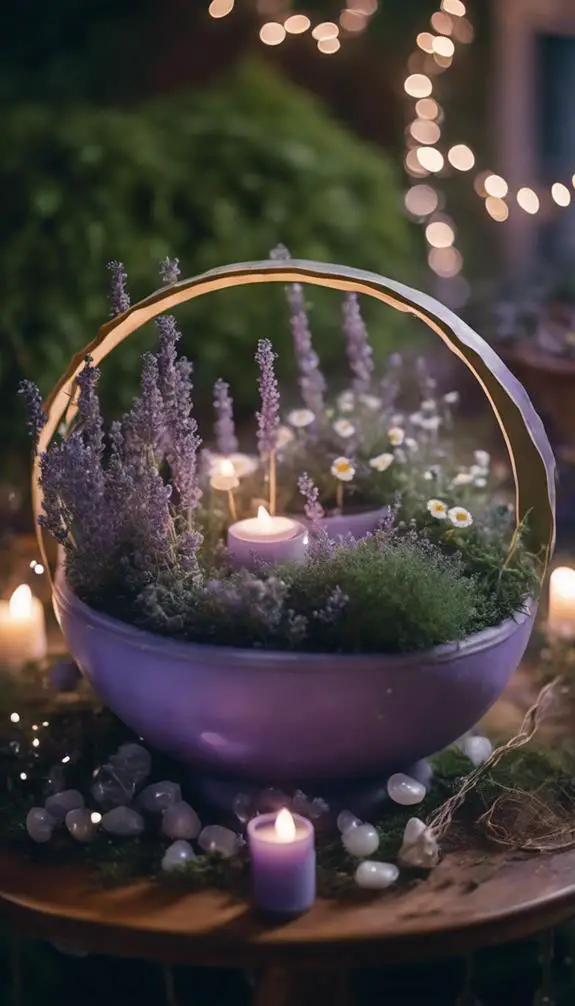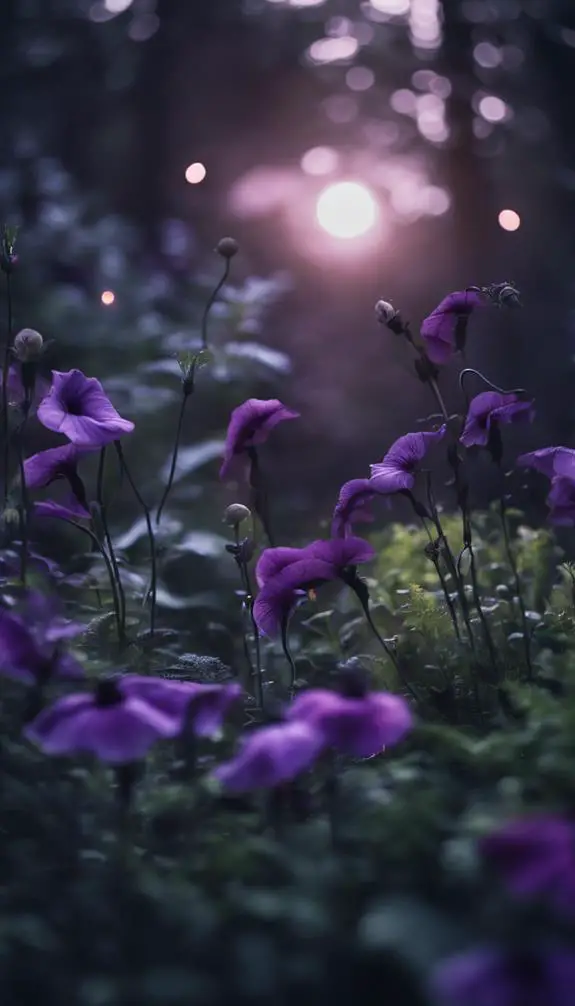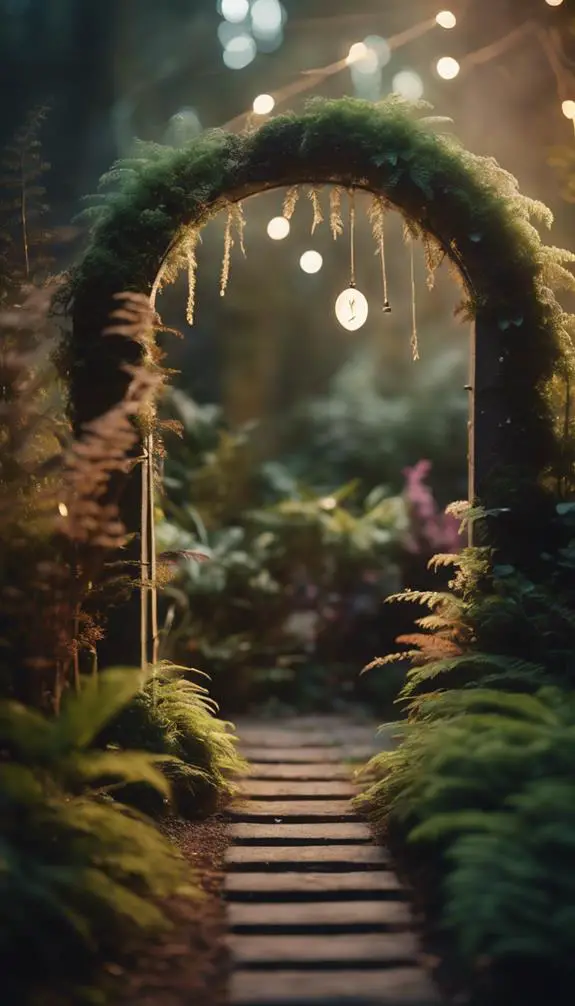As you stand in your backyard, envisioning the perfect outdoor oasis, you're likely wondering where to start. You've got a sense of what you want – a space that's both beautiful and functional – but turning that vision into reality can be overwhelming. You'll need to ponder your personal style, the yard's conditions, and your budget, all while prioritizing the essential elements that will bring your space to life. But what if you could create a harmonious blend of form and function, crafting a unique retreat that's all your own? Let's explore the key elements that will help you get there.
Defining Your Backyard Style

As you set out on designing your outdoor oasis, pinpointing your personal style is crucial, so take a moment to reflect on the aesthetic that resonates with you, whether it's modern and sleek, rustic and natural, or a fusion of eclectic elements.
This introspection will help you identify the visual language that speaks to your personal taste.
Consider your lifestyle priorities: do you need ample seating for frequent gatherings or a quiet nook for solo relaxation? Think about the activities you'll be doing in your backyard – will you be hosting dinner parties, practicing yoga, or simply enjoying a morning coffee?
Your answers will guide your design decisions and guarantee that your outdoor space is tailored to your unique needs.
Assessing Your Yard's Conditions

As you step into your yard, take note of the sun's path and the areas that receive shade throughout the day.
Next, inspect the soil's texture and moisture levels to determine its type and drainage capabilities.
Yard Sun and Shade
You'll need to observe your yard's sun and shade patterns throughout the day to identify areas that receive direct sunlight, partial shade, or remain in shadow.
Understanding sun patterns is essential, as they impact plant growth, outdoor living spaces, and energy efficiency. Note the times of day when the sun rises and sets, and how its rays interact with your yard's topography and surrounding structures.
This will help you determine the best locations for plants, seating areas, and shade-providing features.
Developing effective shade strategies is also imperative. Consider the type and placement of trees, shrubs, and other vegetation to create dappled shade or block intense sunlight.
You can also incorporate architectural elements, such as pergolas, awnings, or umbrellas, to filter or block the sun's rays.
Soil Type and Drainage
Your yard's soil type and drainage patterns substantially impact the health and sustainability of your outdoor space, and understanding these conditions is crucial for selecting suitable plants, designing effective hardscapes, and preventing water-related issues.
To assess your yard's soil type, consider conducting a soil test, which will provide valuable insights into its pH level, nutrient content, and structure.
This information will help you choose plants that thrive in your specific soil conditions, reducing the need for excessive fertilizers and pesticides.
Next, evaluate your yard's drainage patterns by observing how water flows and accumulates after rainfall.
Look for areas where water tends to collect, as these may indicate poor drainage.
Implementing effective drainage solutions, such as installing French drains or rain gardens, can help redirect water and prevent erosion, puddles, and waterlogged soil.
Existing Landscaping Features
With your soil type and drainage patterns assessed, it's time to take stock of your yard's existing landscaping features, including trees, gardens, patios, and other elements that will influence your overall design.
Take note of the mature trees, their size, shape, and canopy coverage. Are they providing shade or obstructing sunlight? Identify the native plants that are already thriving in your yard, as they'll require less maintenance and care.
Observe the existing hardscapes, such as patios, walkways, and retaining walls. Are they in good condition or do they need repairs or replacement? Consider how these features will integrate with your new design.
Take photos and measurements of these elements to reference later.
As you assess your yard, think about how you want to use each space. Do you want to create a seating area under a shaded tree or a vegetable garden in a sunny spot?
Setting a Realistic Budget

Establishing a realistic budget from the outset is crucial, as it enables homeowners to prioritize their wants and needs, allocating resources effectively to avoid costly surprises down the line.
You'll need to contemplate budget constraints and financial priorities to determine how much you can afford to spend on your backyard design.
Start by making a list of the essential elements you want to include, such as a patio, garden, or outdoor kitchen.
Then, assign a rough estimate to each item, researching costs online or consulting with a contractor.
Be honest with yourself about what you can realistically afford, and prioritize your must-haves over your nice-to-haves.
Remember to also factor in ongoing maintenance costs, such as lawn care and water bills.
Choosing a Focal Point

When designing your backyard, you'll want to create a focal point that draws the eye and directs visual flow.
This main attraction can be a statement piece, such as a water feature, sculpture, or bold planting, that anchors the space and creates visual interest.
Main Attraction Ideas
To create visual interest and draw the eye to a specific area, you can choose a main attraction or focal point in your backyard, such as a statement piece of art, a water feature, or a bold architectural element.
This focal point will anchor the space and guide the viewer's attention.
A focal statue, for instance, can add a touch of elegance and sophistication, while a statement wall can create a bold, modern look.
Consider the style and theme of your backyard when selecting your main attraction.
If you have a modern, minimalist space, a sleek water feature or a geometric-shaped planter might fit the bill.
For a more rustic or natural setting, a large stone or wooden sculpture could be the perfect choice.
Visual Flow Control
By strategically placing a focal point, you can direct the viewer's gaze through your backyard, creating a sense of visual flow that guides their attention to specific areas of interest.
This focal point becomes a focal anchor, drawing the eye towards it and influencing how the viewer navigates your outdoor space.
To control visual flow effectively, consider the placement of visual barriers, such as trellises, screens, or hedges, to create a sense of depth and layering.
By positioning these barriers thoughtfully, you can channel the viewer's attention towards the focal point, creating a sense of tension and release.
For example, a strategically placed trellis can create a visual corridor that leads the eye to a stunning water feature or a vibrant garden bed.
Selecting Outdoor Materials
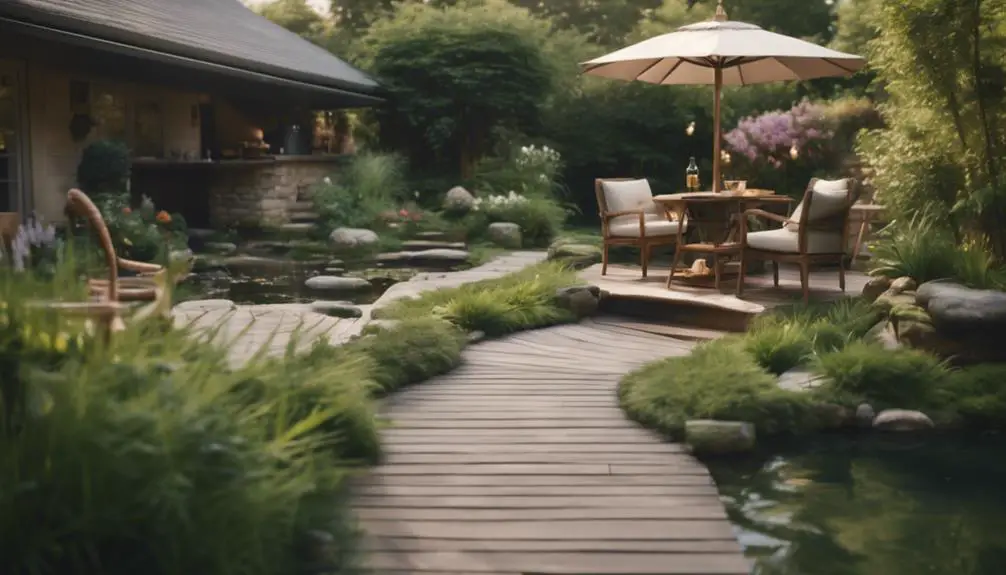
Selecting the right outdoor materials for your backyard design involves balancing aesthetics, durability, and functionality to create a seamless shift between your indoor and outdoor spaces.
When choosing materials, you'll want to prioritize material durability to guarantee your outdoor features can withstand the elements. Consider materials like recycled plastic, sustainably sourced wood, and durable metals that can resist corrosion.
You'll also want to think about sustainable sourcing, opting for materials that are locally sourced, recycled, or reclaimed. Not only will this reduce your carbon footprint, but it'll also add a unique touch to your design.
For example, using reclaimed wood for your outdoor furniture or decking can add a touch of warmth and character to your space.
In terms of functionality, think about how you want to use your outdoor space. If you plan to host frequent gatherings, you may want to choose materials that are easy to clean and maintain.
Whatever materials you choose, make sure they align with your design vision and meet your functional needs. By balancing these factors, you'll create a cohesive and inviting outdoor space that flows seamlessly from your indoor areas.
Incorporating Functional Zones
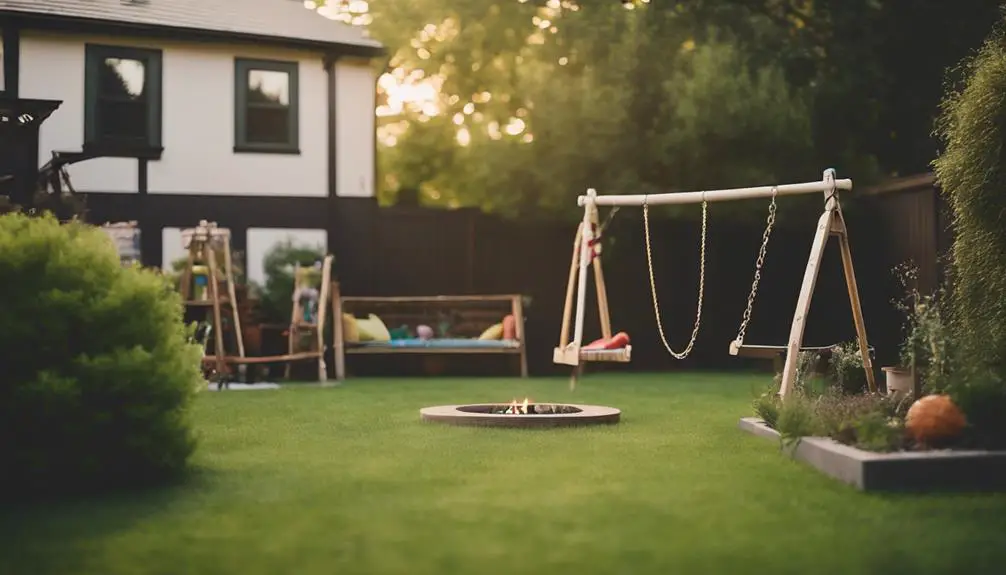
As you design your backyard, you'll want to create distinct functional zones to enhance usability and visual appeal.
You'll need to decide on a zone segregation strategy, determining how to separate areas for relaxation, entertainment, and recreation.
Zone Segregation Strategy
Divide your backyard into functional zones, such as a dining area, lawn, and vegetable garden, to create a harmonious and efficient outdoor space that caters to your specific needs and activities.
This zone segregation strategy enables you to allocate space effectively, ensuring each area serves a distinct purpose.
To implement this strategy, start by creating a zone map, which visualizes your backyard as a series of interconnected spaces.
Group activities that share similar requirements, such as relaxation, entertainment, or recreation, into distinct zones.
For instance, a dining area and outdoor kitchen can be combined in a social zone, while a lawn and playground can be designated as a recreational zone.
This activity grouping approach allows you to optimize the use of space, reducing clutter and improving overall functionality.
Outdoor Room Creation
By allocating specific zones for various activities, you can now create inviting outdoor rooms that flow seamlessly from one functional area to another, fostering a sense of continuity and visual appeal.
This thoughtful approach allows you to craft a harmonious outdoor space that caters to your unique lifestyle.
When designing your outdoor room, consider incorporating functional zones that cater to different activities, such as alfresco living, dining, and relaxation.
Outdoor kitchens, for instance, can be seamlessly integrated into your design, providing a central hub for food preparation and entertainment.
By defining these zones, you can create a sense of purpose and functionality, making your outdoor space feel more intentional and inviting.
To achieve a cohesive look, select materials, textures, and colors that complement each other, ensuring a visual flow between zones.
Additionally, consider the scale and proportion of each zone, ensuring that they work harmoniously together to create a sense of balance and harmony.
Adding Ambiance With Lighting
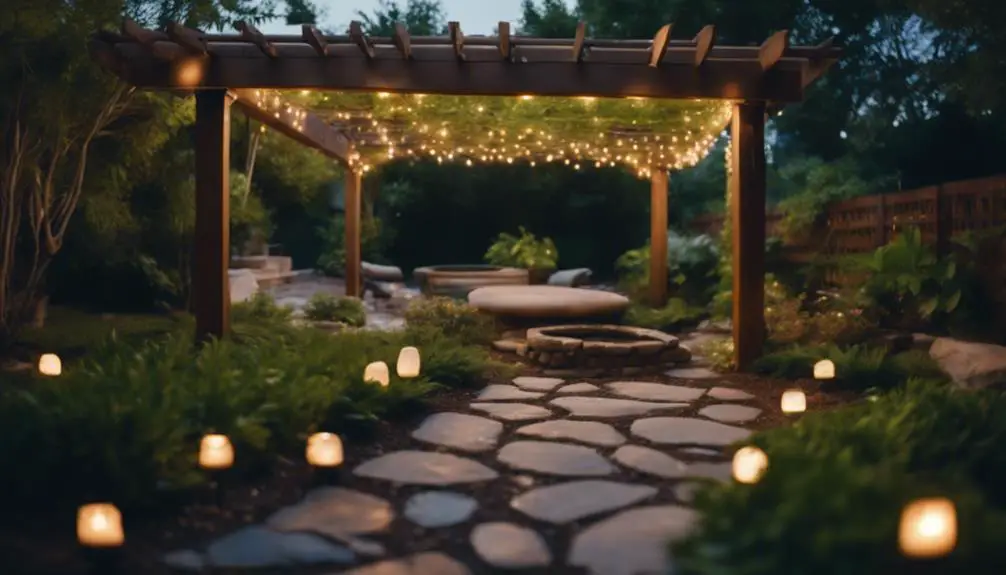
With the sun dipping below the horizon, outdoor lighting takes center stage, transforming your backyard into an inviting oasis that beckons you to linger longer.
As the stars begin to twinkle, you'll want to create a warm and welcoming ambiance that draws you in.
To achieve this, consider incorporating Moonlit Pathways, which use strategically placed pathway lights to create a soft, ethereal glow. This will guide you and your guests through your outdoor space, creating an enchanting atmosphere perfect for a relaxing evening stroll.
To take your lighting design to the next level, consider layering different light sources to create a Twilight Ambiance.
This can include a combination of uplighting, downlighting, and cross-lighting to create depth and visual interest.
By using a mix of warm and cool tones, you can create a dynamic ambiance that's both inviting and sophisticated.
Using Color to Set the Mood

As you tailor your backyard design to evoke a specific mood, carefully selecting a color scheme can transport you to a serene escape, elevating the ambiance and emotional connection to your outdoor space.
This is where Color Psychology comes into play, as different hues can stimulate distinct emotions and reactions. Cool tones like blues and greens can induce feelings of calmness, while warm tones like oranges and yellows can energize and uplift.
To create a cohesive look, start by building a Mood Board, a visual representation of your desired aesthetic.
Gather inspirational images, fabric swatches, and color chips to get a sense of how different hues interact. Consider the natural surroundings, architectural style, and furniture choices to guarantee a harmonious palette.
You can also experiment with online color picker tools to find the perfect shade. By thoughtfully selecting a color scheme, you'll be able to craft an immersive atmosphere that resonates with your vision.
Bringing in Texture and Pattern
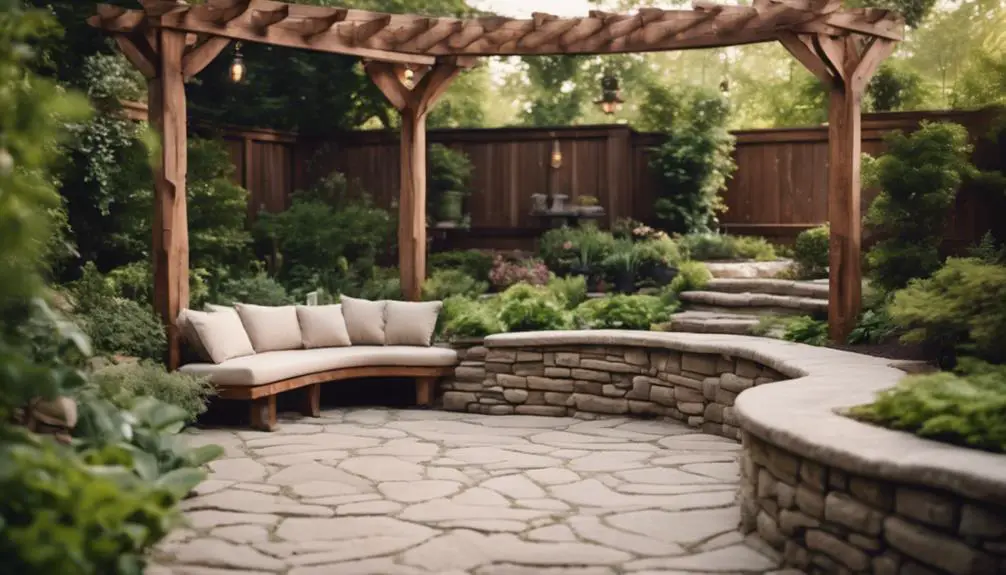
You'll further enrich your backyard design by incorporating a variety of textures and patterns, which will add depth, visual interest, and tactility to your outdoor space.
Rough hardscapes, such as gravel, brick, or stone, provide a striking contrast to soft landscaping elements like lush grass, flowers, or shrubs. By combining these textures, you'll create a visually appealing contrast that invites exploration.
To add pattern to your design, consider incorporating repeating elements like pavers, tiles, or wooden decking. These patterns can be used to create a sense of movement or direction, drawing the eye to a particular feature or area of your yard.
You can also use plants with varying leaf shapes, sizes, and colors to add visual interest and create a dynamic pattern.
When selecting textures and patterns, consider the overall aesthetic you want to achieve in your backyard. Do you want a modern, sleek look or a more rustic, natural feel?
Creating a Sense of Privacy
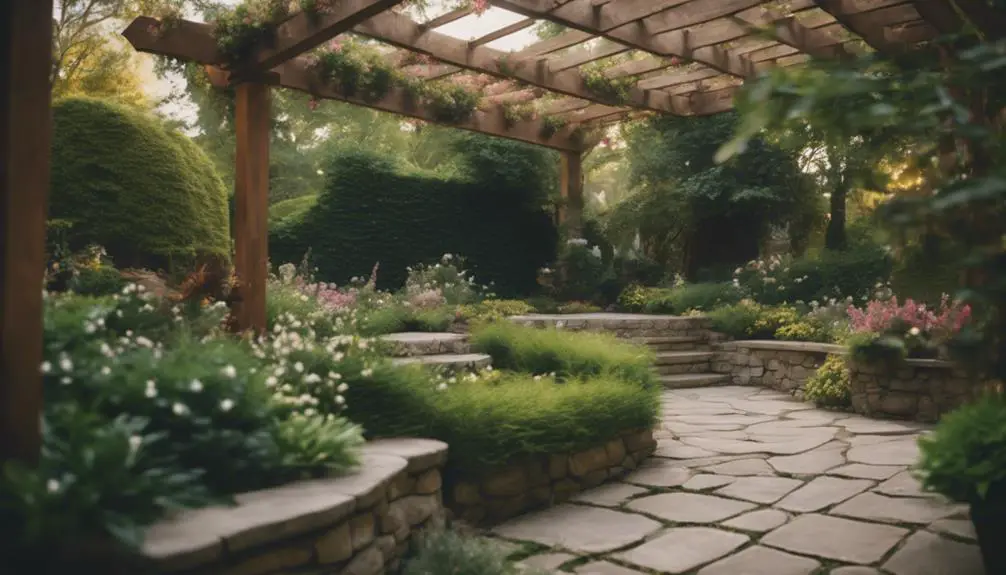
Beyond the visual appeal of texture and pattern, a well-designed backyard also requires careful consideration of spatial boundaries to create a sense of seclusion and intimacy.
As you design your outdoor space, think about how you can craft private havens that shield you from the outside world. Strategically placed screens, trellises, or pergolas can define different areas within your yard, creating secluded escapes that feel like miniature oases.
Consider the orientation of your furniture, too. By positioning seating areas in a way that creates a sense of enclosure, you can foster a feeling of coziness and seclusion.
Planting dense foliage or installing a living wall can further reinforce this sense of privacy, blocking out views from neighboring properties or passing pedestrians.
Incorporating Water Features
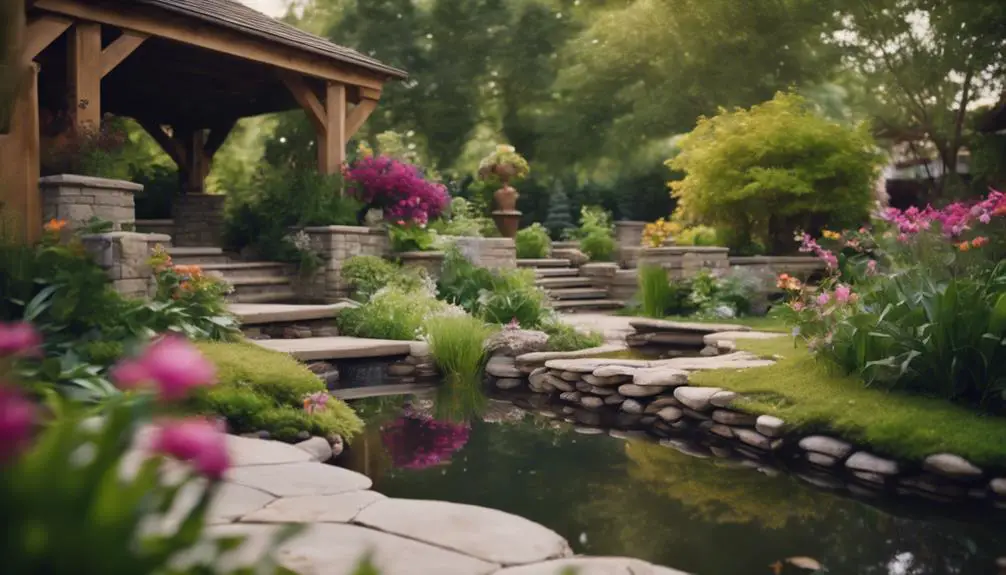
By introducing the soothing sounds and visual interest of water features, you can elevate your backyard's ambiance and create a sense of tranquility that complements your carefully crafted private havens.
Water features can be incorporated in various forms, including water walls, fountains, and ponds.
When designing a water feature, consider the scale and proportion of the element in relation to your backyard's size and layout. For instance, a small fountain can be placed near a seating area to create a cozy atmosphere, while a larger water wall can serve as a striking focal point.
Fountain placement is vital, as it can either create a sense of harmony or disrupt the flow of your outdoor space. Strategically position your fountain to draw the eye towards a specific area or to create a sense of symmetry.
Adding Outdoor Furniture
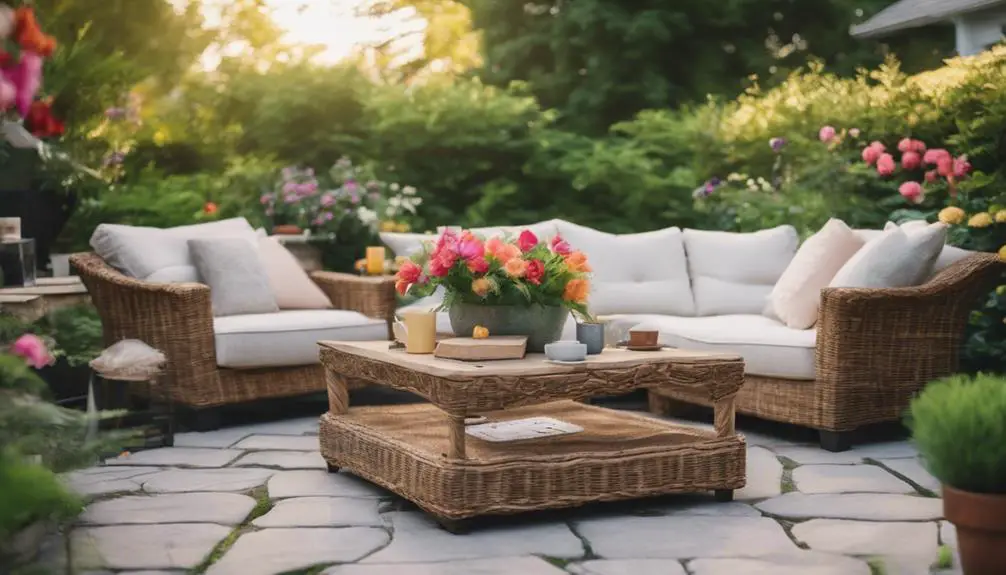
How can you strategically place outdoor furniture to create functional zones and define the purpose of each area within your backyard retreat?
Start by identifying the activities you want to prioritize, such as dining, lounging, or entertaining. Then, choose furniture pieces that cater to each activity, considering factors like comfort, durability, and style.
Current furniture trends emphasize comfort and versatility, so opt for multi-functional pieces like sectional sofas with built-in storage or coffee tables with lift-tops.
When it comes to furniture placement, think about the flow of traffic and the direction of sunlight. Place seating areas in shaded spots, and position tables and chairs to facilitate conversation.
Don't forget to leave enough space between pieces to create a sense of breathability. By thoughtfully arranging your outdoor furniture, you'll create a harmonious and functional space that invites relaxation and socialization.
Balancing Form and Function
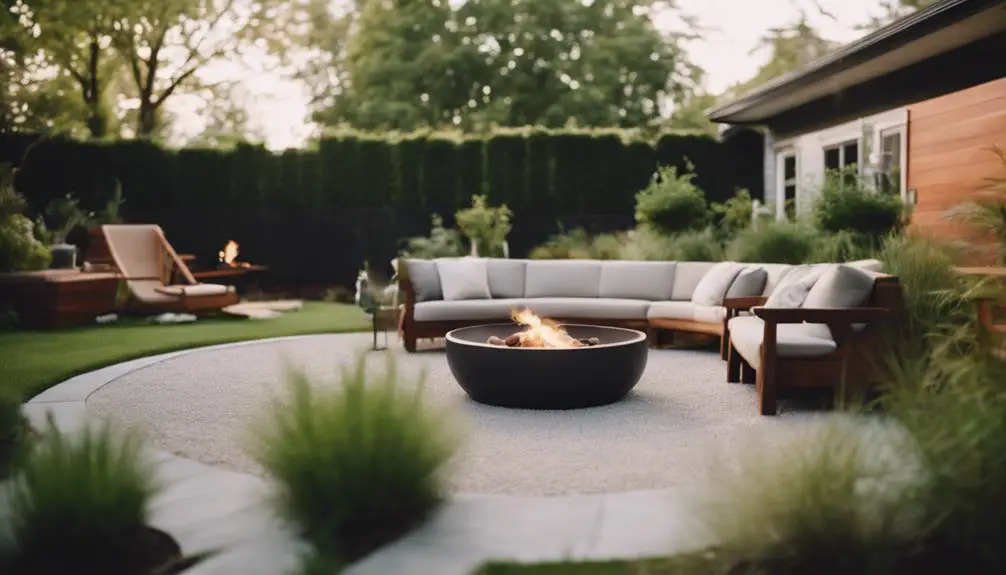
As you curate your outdoor space, you'll need to reconcile the aesthetic appeal of your design with its functional purpose, ensuring that every element serves a deliberate role in creating a harmonious and inviting atmosphere.
This delicate balance between form and function is pivotal in crafting a backyard that not only looks stunning but also meets your lifestyle needs.
To achieve this balance, consider the formal elegance of clean lines, symmetrical layouts, and structured plantings. These elements can create a sense of sophistication and refinement, perfect for hosting dinner parties or relaxing with family.
However, don't be afraid to inject a touch of whimsical contrast to break the monotony. Add an unexpected pop of color, a statement piece of art, or an unusual plant species to create visual interest and personality.
By thoughtfully combining these contrasting elements, you'll create a unique and enchanting outdoor space that's both beautiful and functional.
Frequently Asked Questions
How Do I Keep My Backyard Design Consistent Over Time?
To maintain a consistent aesthetic, you'll want to define your personal style and use it as a guide for selecting seasonal themes, ensuring cohesion across time through intentional, deliberate design choices that reflect your unique vision.
Can I DIY My Backyard Design or Do I Need a Pro?
When tackling a project, you're often faced with the dilemma: DIY or hire a pro? Considering budget constraints and personal style, you'll need to weigh the value of your time and expertise against the cost of professional guidance.
How Often Should I Update My Backyard Design?
You'll want to refresh your space every 3-5 years to reflect your personal evolution and incorporate seasonal refreshes, ensuring your outdoor haven remains a vibrant reflection of your evolving style and tastes.
Are Backyard Design Trends Worth Following or Fleeting?
When considering trends, you'll wonder if they're worth following or fleeting. In reality, they're a reflection of collective personal style, and embracing design evolution allows you to curate a unique space that's authentically yours.
Can a Small Backyard Still Have a Big Impact?
You can craft intimate spaces that pack a punch, even in compact areas. Think small wonders like vertical gardens, clever lighting, and sleek furniture that create a sense of grandeur in tiny, tailored oases.
Conclusion
As you refine your backyard design, remember that harmony lies in balance.
Blend your unique style with functional zones, and don't forget to incorporate ambiance and texture.
By doing so, you'll create an enchanting retreat that mirrors your personality.
With a realistic budget and thoughtful planning, your outdoor space will become an extension of your indoor living area, where you can relax, entertain, or pursue your passions, surrounded by the beauty and tranquility you've carefully crafted.


